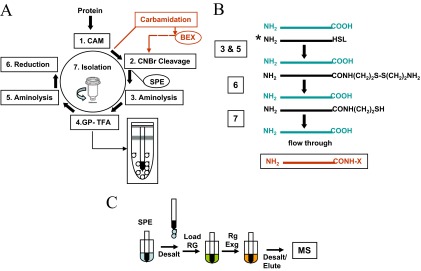Figure 1.

(A) Flow chart of sample preparation for C-terminal CNBr peptide isolation. The reaction steps are numbered and highlighted with boxes. Whole, intact protein is reduced and carboxyamidomethylated (Step 1), followed by CNBr cleavage (Step 2) in a one-pot reaction sequence. The digest is adsorbed on ZipTipC18 reversed-phase supports [solid-phase extraction (SPE)], used as a venue for conjugation of the newly exposed homoserine lactone-terminated N-terminal and internal CNBr fragments with cystamine (Step 3), followed by gas-phase lactonization of residual, homoserine-terminated material (Step 4) and conjugation with cystamine (step 5). After reductive release of 2-aminoethane thiol from the fully formed conjugation products (Step 6), the thiol-functionalized N-terminal and internal peptides are depleted on activate thiol sepharose (Step 7), leaving the C-terminal peptide in the flow-through fraction. CAM denotes carboxyamidomethylation; GP-TFA designates gas-phase reaction step. The reactor is depicted schematically in the inset. The reaction path highlighted in red indicates the incorporation of protein carboxyl group carbamidation in the one-pot reaction scheme (see text for details on the use of the modified reaction scheme). BEX denotes buffer exchange of the carbamidated reaction mixture. (B) Schematic representation of the analyte, the intermediate reaction products, and the C-terminal isolate. HSL denotes homoserine lactone the asterisk denotes conjugation target. The carbamidated C-terminal isolate is highlighted in red. CONH-X denotes the carbamoyl residue. (C) Schematic representation of solid-phase sequential sample handling. The analyte is extracted on the solid-phase support (SPE), followed by a desalting step. The reaction cycle is initiated by loading the reagent onto the support. Reagents are sequentially exchanged directly on the resin bed (Rg Exg), eliminating intermittent sample purification. Note that the C18 reversed-phase tip is left immersed in reagent during incubation. The two-step reaction scheme is concluded by a solvent wash before product elution and MALDI-TOF or electrospray ionization (ESI) tandem MS.
